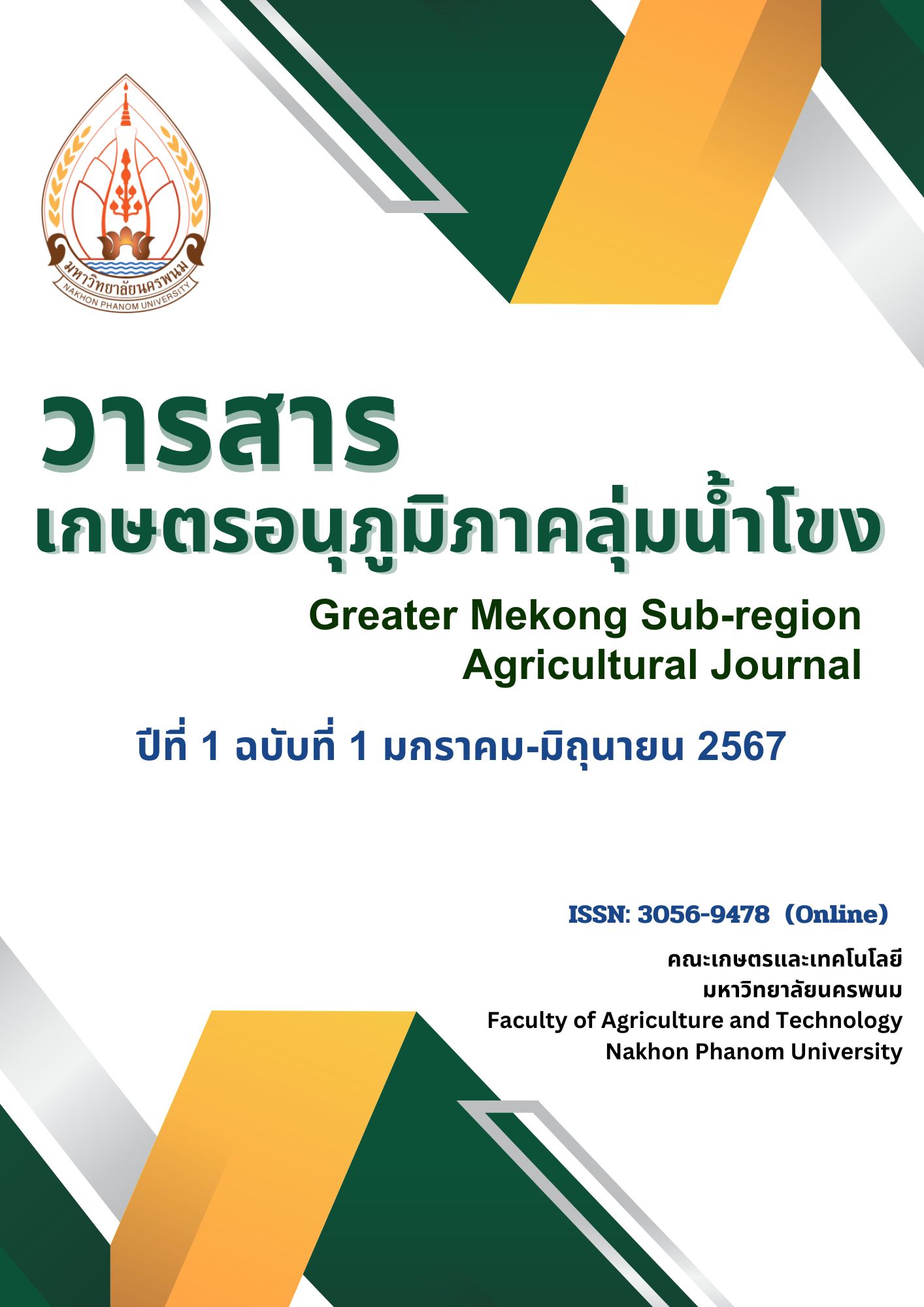Development of germinated parboiled rice cracker supplemented with kale (Brassica oleracea L. var. acephala DC) powder
Main Article Content
Abstract
The research aims to investigate the effects of adding 0%, 2.5%, 5.0%, and 7.5% of kale powder by weight (formulas 1, 2, 3, and 4, respectively) on the physicochemical quality and sensory acceptance of the product. The results found that added of kale powder affects to the color, texture, spread ratio, and the aw of the products (formulas 2 - 4) significantly different from the sample without kale powder (formula 1). The increased in kale powder content decreased the L*, a*, b*, and C* values. Formula 4, 7.5% kale powder, has the lowest L*, a*, b*, and C* values, in the range of 34.23, -0.29, 14.35, and 103.1 respectively. The germinated parboiled rice cracker supplemented with kale powder have a color shade ranging from yellow to green (hue angle 90° - 180°), while those without kale powder addition have a color shade ranging from red to yellow (hue angle 0° - 90°). It was founded that formulas added kale powder showed a lower spread ratio in the range of 7.00 - 8.49 and the hardness in the range of 2,105.00 - 2,494.08 g as compared to the control sample (formula 1: without kale powder) which had values of 12.83 and 3,236.67 g, respectively. All formulas have aw in the range of 0.3797 to 0.5822, and less than 0.6 according (aw = 0.6) TCPS: 523/2020. The cracker with 5% kale powder had the highest sensory overall liking score. The acceptance score of overall liking were 7.53.
Article Details

This work is licensed under a Creative Commons Attribution-NonCommercial-NoDerivatives 4.0 International License.
บทความลิขสิทธิ์ที่ได้รับการตรีพิมพ์เป็นลิขสิทธิ์ของวารสารเกษตรอนุภาคภูมิภาคลุ่มน้ำโขง คณะเกษตรและเทคโนโลยี มหาวิทยาลัยนครพนม
References
โชติกานต์ แขนอก, วิภา ลำพาย, อรัญญา พรหมกูล และอาภัสสร ศิริจริยวัตร. 2565. การพัฒนาบราวนี่ปราศจากกลูเตนจากแป้งข้าวฮางงอก. วารสารวิทยาศาสตร์บูรพา. 27(2), 1393-1406.
ญาณิศา โพธิ์รัตน์โส, สุนันท์ บุตรศาสตร์ และพรพิษณุ ธรรมปัทม์. 2562. การพัฒนาผลิตภัณฑ์แครกเกอร์ฟักทองปลอดกลูเตน. วารสารเกษตรพระวรุณ. 16(2), 221-227.
สุภกาญจน์ พรหมขันธ์ พนอจิต นิติสุข และศุกฤชชญา เหมะธุลิน. 2556. รายงานการวิจัย เรื่องการพัฒนาผลิตภัณฑ์เครื่องดื่มเพื่อสุขภาพชนิดผงพร้อมชงจากข้าวฮางงอก ประจำปีงบประมาณ 2556. มหาวิทยาลัยเทคโนโลยีราชมงคลอีสาน: สกลนคร.
สำนักงานมาตรฐานผลิตภัณฑ์อุตสาหกรรม กระทรวงอุตสาหกรรม. 2563. มาตรฐานผลิตภัณฑ์ชุมชน เรื่อง ขนมปังกรอบ (มผช.523/2563). สืบค้น วันที่ 12 ธันวาคม 2566, จาก https://tcps.tisi.go.th/pub/tcps0523_63 (ขนมปักรอบ).pdf.
อุไรวรรณ วัฒนกุล, ศุภลักษณ์ สุดขาว และพีรพงษ์ พึ่งแย้ม. 2561. รายงานการวิจัย เรื่อง คุณภาพทางเคมี-กายภาพ และสารออกฤทธิ์ทางชีวภาพในผลิตภัณฑ์ข้าวกล้องงอกหุงสุกเร็วจากข้าวกล้องงอกผสม 3 สายพันธุ์ ประจำปีงบประมาณ 2561. มหาวิทยาลัยเทคโนโลยีราชมงคลศรีวิชัย.
AACC. 2000. Approved Methods of the AACC. 10th Ed. St Paul: American Association of Cereal Chemists.
Drisya, C.R., Swetha, B.G., Velu, V., Indrani, D. and Singh, R.P. 2015. Effect of dried Murraya koenigii leaves on nutritional, textural and organoleptic characteristics of cookies. Journal of Food Science and Technology. 52(1), 500-506.
Gallagher, E., Gormley, R.T. and Arendt, K.E. 2004. Recent advances in the formulation of gluten-free cereal-based products. Trends in Food Science & Technology. 15, 143-152.
Kahlon, T.S., Chapman, M. H., and Smith, G.H. 2007. In vitro binding of bile acids by spinach, kale, brussels sprouts, broccoli, mustard greens, green bell pepper, cabbage and collards. Food Chemistry. 100(4), 1531-1536.
Kim, S.Y. 2017. Production of fermented kale juices with Lactobacillus Strains and nutritional composition. Preventive Nutrition and Food Science. 22(3), 231-236.
Sattasuwan, N., Nuengjamnong, N and Suksomboon, A. 2010. Development of rice crackers (Arare) from black glutinous rice. Agricultural Science Journal. 41(3/1)(Suppl.): 165 168.
USFDA. 2014. Water Activity (aw) in Foods. January 13, 2024, Retrieved, from: https://www.fda.gov.
USDA. 2019. Kale, raw. December 13, 2023, Retrieved, from: https://fdc.nal.usda.gov/fdc-app.html#/food-details/168421/nutrients


